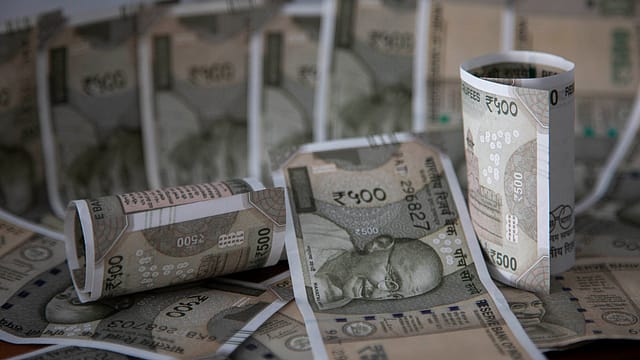There is no distress: Finance Ministry on drop in household savings
ADVERTISEMENT

The finance ministry of Thursday clarified that household savings have moderated due to changing consumer preference for different financial products and there is no distress as is being circulated in some circles.
Households added net financial assets of ₹22.8 lakh crore in FY21, nearly ₹17 lakh crore in FY22 and ₹13.8 lakh crore in FY23, according to RBI data.
"They added less financial assets to their portfolio than in the previous year and the year before, but it is important to note that their overall net financial assets are still growing," the finance ministry says in a clarification on microblogging platform X.
Households added financial assets by a lesser magnitude than in the previous years because they have now started taking loans to buy real assets such as homes, the ministry says.
"Between June 2020 and March 2023, the stock of household gross financial assets went up by 37.6%, and the stock of household gross financial liabilities went up by 42.6%," the government says, claiming that there is no big difference between the two.
There has been a steady double-digit growth in loans for housing since May 2021, highlighting that financial liabilities have been incurred to buy real assets, the ministry says. Vehicle loans have been growing at double digits since April 2022 and more than 20% since September 2022, it says.
January 2026
Netflix, which has been in India for a decade, has successfully struck a balance between high-class premium content and pricing that attracts a range of customers. Find out how the U.S. streaming giant evolved in India, plus an exclusive interview with CEO Ted Sarandos. Also read about the Best Investments for 2026, and how rising growth and easing inflation will come in handy for finance minister Nirmala Sitharaman as she prepares Budget 2026.
"The household sector is not in distress, clearly. They are buying vehicles and homes on mortgages," says the government.
"Overall household savings, which includes financial, physical and jewellery, have grown at a CAGR of 9.2% between 2013-14 and 2021-22. Nominal GDP has grown at a CAGR of 9.65% during the same period. Hence, household savings/nominal GDP has remained constant - from around 20.3% to 19.7% as of FY22," the finance ministry explains.
The drop in household savings is due to the net flow of credit from non-banking financial corporations (NBFC) to the household sector, the ministry says. The household sector in the national accounts includes, apart from individuals, all non-government, non-corporate enterprises like farm and non-farm businesses, unincorporated establishments such as sole proprietorships and partnerships and non-profit institutions.
"In FY22, NBFC had lent only ₹21,400 crore to the household sector. In FY23, they had lent nearly ₹240,000 crore, the ministry says, adding that this is a whopping 11.2 times increase.
NBFC retail loans outstanding were ₹8.12 lakh crore in FY22, and it went up to ₹10.5 lakh crore in FY23, a growth of 29.6%.
The two big components in NBFC retail loans are vehicle loans and 'other retail loans'. Vehicle loan outstanding increased by about 12.5%, from ₹3.4 lakh crore in FY22 to ₹3.82 lakh crore in FY23. Other retail loans went up from ₹3.95 lakh crore to ₹5.22 lakh crore, the ministry says, adding that these are microfinance loans, loans to self-help groups, advances to individuals against gold and other loans.
"36% of NBFC's outstanding retail loans are for the purchase of vehicles. That is not a sign of distress on the part of households but of confidence in their future employment and income prospects," the government says.
The net financial saving of the household sector moderated to 5.1% of GDP in FY23 from 11.5% in FY21 and 7.6% from FY20 (pre-pandemic), according to a report by SBI Research. SBI's Ecowrap report, however, says household savings must be looked into as a sum total of physical and financial savings.
Financial liabilities jumped ₹8.2 lakh crore since the pandemic, outpacing the increase in gross financial savings at ₹6.7 lakh crore, thus explaining the fall in household net financial saving by ₹1.5 lakh crore or 2.5% of GDP, the report says.
It is entirely possible that a low-interest rate regime resulted in a paradigm shift of household financial savings to household physical savings in the last two years, the SBI report says.
According to the report, the decline in net financial savings of households has resulted in an increase in household savings in gross physical assets. "Savings in physical assets which accounted for more than two-thirds of household savings in FY12, had declined to 48% in FY21. However, the trend is again shifting and the share of physical assets is expected to reach around 70% level in FY23, due to decline in share of financial assets," it says.
"We also believe that the shift to physical assets is also triggered by a recovery in real estate sector and the increase in property prices. The RBI House Price Index shows a modest acceleration since FY21, which may be acting as a motivator for buying homes," the report says, adding that this increased pull factor thereby pushing up capital spends in a multitude of sectors. "If this is indeed the proximate story of the revival in household investment, this has strong policy implications for growth and investment revival."
The recovery in investment in the household sector thus bodes well for the informal sector also, the report says.
